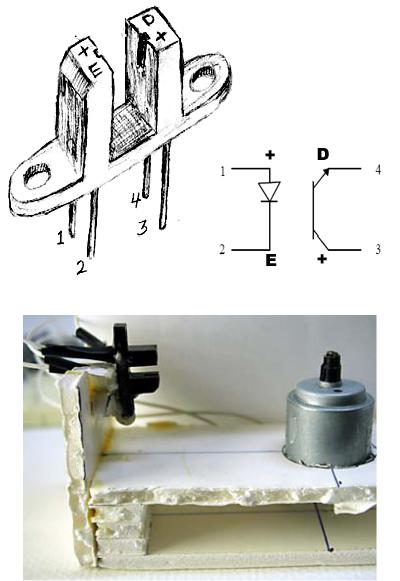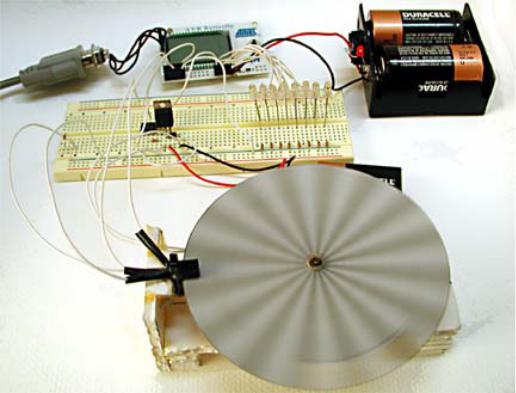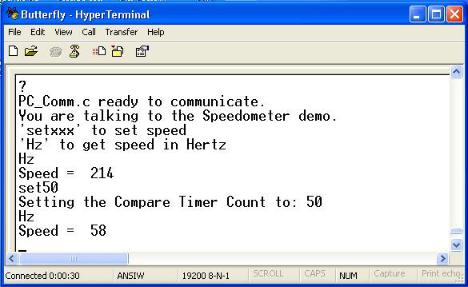
- •Chapter 1: Introduction
- •Goals
- •Chapter 2: Quick Start Guide
- •Software
- •WinAVR – Oh, Whenever…
- •Programmers Notepad
- •AVRStudio – FREE and darn well worth it.
- •Br@y++ Terminal:
- •Hardware
- •Constructing Your Development Platform
- •Blinking LEDs – Your First C Program
- •Write it in Programmers Notepad
- •Download to the Butterfly with AVRStudio
- •Blinky Goes Live
- •Simulation with AVRStudio
- •GOOD GRIEF!
- •Comments
- •Include Files
- •Expressions, Statements, and Blocks
- •Operators
- •Flow Control
- •Functions
- •The Main() Thing
- •Chapter 4: C Types, Operators, and Expressions
- •Data Types and Sizes
- •Seen on a shirt at a Robothon event:
- •Bits
- •Bytes
- •The long and short of it
- •Variable Names
- •Constants
- •Declarations
- •Arithmetic Operators
- •Relational and Logical Operators
- •Bitwise Operators
- •Testing Bits
- •Assignment Operators and Expressions
- •Conditional Expressions
- •Precedence and Order of Evaluation
- •Projects
- •Port Input and Output
- •Cylon Eye Speed and Polarity Control
- •Chapter 5: C Control Flow
- •Statements and Blocks
- •If-Else and Else-If
- •Switch
- •Loops – While, For and Do-while
- •Break and Continue
- •Goto and Labels
- •A few practical examples: strlen, atoi, itoa, reverse
- •Chapter 6: C Functions and Program Structures
- •Function Basics
- •Returns
- •Variables External, Static, and Register
- •Scope
- •Headers
- •Blocks
- •Initialization
- •Recursion
- •Preprocessor
- •Macro Substitution
- •Conditional Inclusion
- •Projects
- •Is anybody out there? Communicating with a PC
- •Demonstrator
- •PC_Comm
- •Using CommDemo:
- •Chapter 7: Microcontroller Interrupts and Timers
- •Interrupts
- •Projects
- •Grab your joystick – and test your interrupts
- •Using joystick
- •Timers/Counters
- •Calibrating the Butterfly oscillator:
- •OSCCAL_calibration() function – detailed explanation
- •ALL THIS AND WE HAVEN’T EVEN STARTED CALIBRATING YET!
- •Projects
- •Precision Blinking
- •Using Precision Blinking:
- •Pulse Width Modulation – LED Brightness Control
- •Pulse Width Modulation - Motor Speed Control
- •Speedometer
- •Chapter 8: C Pointers and Arrays
- •Addresses of variables
- •Function Arguments
- •Arrays
- •FIFOs and LIFOs: Stacks and Queues (Circular Buffers)
- •Stacks
- •Queues (Circular Buffers)
- •Function Pointers
- •Complex Pointer and Array Algorithms
- •Projects
- •Messenger
- •Arrays in RAM and ROM
- •Does anybody know what time it is? A Real Time Clock.
- •A one second interrupt
- •Converting Computer Time to Human Readable Time
- •The Real Timer Clock Software
- •Music to my ears. “Play it again Sam.”
- •More on pointers to arrays
- •Setting the frequency
- •Setting the duration
- •An example song array – Fur Elise
- •Using the Piezo-element to make sound
- •Initializing the Timer1 for PWM to the piezo-element.
- •Generating the tone using PWM from Timer1
- •Using the Timer0 interrupt to play a tune
- •Chapter 9 – Digital Meets Analog – ADC and DAC
- •But First - A Debugging Tale
- •Analog to Digital Conversion
- •What is Analog to Digital Conversion?
- •Analog to Digital Conversion by Successive Approximation
- •Analog to Digital Conversion with the ATMEGA169
- •Starting a Conversion
- •Conversion Timing
- •Changing Channels
- •Digital Noise Reduction
- •Conditioning the Analog Input Signal
- •Accuracy
- •Projects
- •Initializing the ADC
- •Reading the ADC
- •Light Meter
- •Temperature Meter
- •The @#%#&*#!!!! Volt Meter
- •Using ADC
- •DAC and ADC - Function Generator / Digital Oscilloscope
- •Chapter 10: C Structures
- •Structure Basics
- •Structures and Functions
- •Structure Arrays
- •Typedef
- •Unions
- •Bit-fields
- •Bit-Fields the C-way
- •Bit-fields the masking-way
- •Projects
- •Finite State Machine
- •Chapter 11 The Butterfly LCD
- •PC to LCD test program
- •Conclusion
- •Appendix 1: Project Kits
- •Data I/O
- •PWM Motor Control
- •Appendix 2: Soldering Tutorial
- •Appendix 3: Debugging Tale
- •Appendix 4: ASCII Table
- •Appendix 5: Decimal, Hexadecimal, and Binary
- •Appendix 6: Motor Speed Control Wheel
- •Appendix 7: HyperTerminal
- •Index
Chapter 7: Microcontroller Interrupts and Timers
Speedometer
We used an optoisolator to separate the motor power circuits from the Butterfly to help lessen the likelihood of blowing something up. A device similar to an optoisolator is an optointerrupter, which has an air channel between the IR light emitting diode and the IR detector transistor, see Figure 23. An opaque object passed between the diode and the detector causes the transistor to turn off thus ‘interrupting’ the current. We can tie the transistor to a pin on the Butterfly and detect the interruption. Did you notice the opening cut in the wheel in Figure 22? (when you cut out the slot, glue it just under the inner side of the slot to help keep the wheel balanced) If you rig up the motor base so that the wheel spins thru the slot in the optointerrupter, each time the opening passes; the transistor turns on and back off when the slot has passed. If we write our software so that a voltage change on the pin attached to the optointerrupter causes an interrupt in the Butterfly, we can count those interrupts. If we count for exactly one second we have the number of times the wheel rotates per second, which is the rotational speed in Hz. Cool!
Solder long wires to the optoisolator, and then add electrical tape to prevent the legs from shorting. Next carefully glue it to the motor base in a position so that the wheel rotates thru it. Make sure the wheel is balanced and will turn cleanly (easier said than done) and fully block and unblock the optoisolator slot as the wheel turns, Figure 22.
144

Chapter 7: Microcontroller Interrupts and Timers
Figure 23: Opto Interrupt Switch - H21A1
Figure 24: Opto Interrupter Glued on Motor Base
Wiring:
•Optoisolator pin 1 to +3v
•Optoisolator pin 2 to a 200 Ohm resistor
145

Chapter 7: Microcontroller Interrupts and Timers
•200 Ohm resistor to Butterfly GND
•Optoisolator pin 3 to PORTB pin 4 (remember counting starts at 0)
•Optoisolator pin 4 to Butterfly GND
You will notice that you learned the mechanical engineering skills needed for this project in kindergarten. Though most kindergarteners could probably do a more attractive job than I did, it works.
Figure 25: Speedometer
Create a Speedometer directory and copy the motor control software to it. Make the following changes in Demonstrator.c:
// Demonstrator.c Speedometer version
#include "PC_Comm.h" #include "Demonstrator.h"
146
Chapter 7: Microcontroller Interrupts and Timers
unsigned char milliseconds = 0;
unsigned int second = 0;//count to 1000 and trigger one second event
unsigned int speed = 0; // IR detector count per second unsigned int lastspeed = 0; // IR detector count per second
void initializer()
{
//Calibrate the oscillator: OSCCAL_calibration();
//Initialize the USART USARTinit();
//Init port pins
DDRB |= 0x08;
PORTB |= ((1<<PINB4));//|(1<<PINB6)|(1<<PINB7));
// Enable pin change interrupt on PORTB
PCMSK1 = ((1<<PINB4));//|(1<<PINB6)|(1<<PINB7)); EIFR = (1<<6)|(1<<7);
EIMSK = (1<<6)|(1<<7);
DDRD = 0xFF; // set PORTD for output
PORTD = 0XFF; // set LEDs off
milliSecInit(127); // 50% duty cycle 1kHz signal
// say hello
sendString("\rPC_Comm.c ready to communicate.\r"); // identify yourself specifically
sendString("You are talking to the Speedometer demo.\r"); sendString("'setxxx' to set speed\r'Hz' to get speed in
Hertz\r");
}
void parseInput(char s[])
{
// parse first character switch (s[0])
{
case 's':
if( (s[1] == 'e') && (s[2] == 't')) parse_set(s);
147
Chapter 7: Microcontroller Interrupts and Timers
break; case 'H':
if( (s[1] == 'z')) sendSpeed(); break;
case 'd':
if( (s[1] == 'e') && (s[2] == 'm') && (s[3] == 'o') && (s[4] == '?') )
sendString("You are talking to the Speedometer demo.\r");
break;
default:
sendString("\rYou sent: '"); sendChar(s[0]);
sendString("' - I don't understand.\r"); break;
}
s[0] = '\0';
}
void sendSpeed()
{
char spd[11];
sendString("Speed = "); itoa(lastspeed,spd,10); sendString(spd); sendChar('\r');
}
int parse_set(char s[])
{
char set[11];
unsigned char i = 3, j = 0;
while( (s[i] != '\0') && (j <= 11) )
{
if( (s[i] >= '0') && (s[i] <= '9') )
{
set[j++] = s[i++];
}
else
{
148
Chapter 7: Microcontroller Interrupts and Timers
sendString("Error - Parse_set received a
non integer: ");
sendChar(s[i]);
sendChar('\r'); return 0;
}
}
set[j] = '\0';
if(j>4)// must be < 256
{
sendString("Error - Parse_set number too large\r"); return 0;
}
else
{
set_speed(atoi(set));
}
return 1;
}
void set_speed(int count)
{
char speed[11];
sendString("Setting the Compare Timer Count to: "); itoa(count,speed,10);
sendString(speed);
sendChar('\r');
milliSecInit(count);
}
/*
The USART init set the system oscillator to 2 mHz. We set the Timer0 prescaler to clk/8 which gives a 250 kHz input to the timer/counter. A compare of 250 throws an interrupt every millisecond.
*/
void milliSecInit(unsigned char count)
{
// Enable timer0 compare interrupt TIMSK0 = (1<<OCIE0A);
149
Chapter 7: Microcontroller Interrupts and Timers
//Sets the compare value setOCR0A(count);
//Set PWM Phase Correct mode, CLK/8 prescaler TCCR0A = (0<<FOC0A)|(0<<WGM01)|(1<<WGM00)|(1<<CS01);
}
void setOCR0A(unsigned char count)
{
// Sets the compare value OCR0A = count;
}
// Interrupt occurs twice per Millisec, timed for PWM SIGNAL(SIG_OUTPUT_COMPARE0)
{
//Toggle PORTD pin 0 if(PORTD &= 1) cbi(PORTD, 0); else sbi(PORTD, 0);
//get the speed count once per second if(second++ >= 1000)
{
second = 0;
lastspeed = speed; // store most recent speed in Hz
speed = 0;
}
}
SIGNAL(SIG_PIN_CHANGE1)
{
speed++;
}
We’ve made a couple of simple changes. We reused the pin interrupt code from the joystick software and in the interrupt routine we increment a speed counter variable. Once per second we copy the speed counter value to ‘lastspeed’ variable, which we report as the speed in Hz when requested.
Compile and load, remembering to reset the AVRStudio programming tool to use the correct PC_Comm.hex, which I forgot AGAIN! Open HyperTerminal, toggle
150

Chapter 7: Microcontroller Interrupts and Timers
the power to the Butterfly, move the joystick to the up position for a moment, and you should see something like the following:
Play with it for a while and you’ll see that this isn’t particularly accurate. But what do you expect for cardboard and glue?
151
